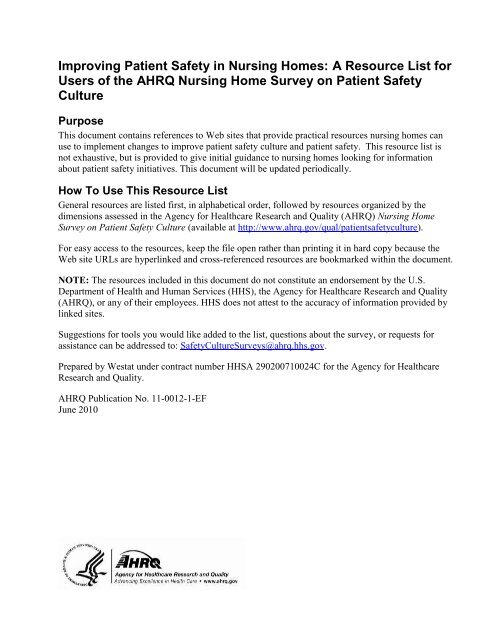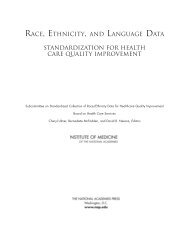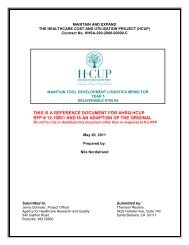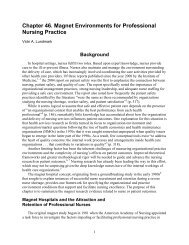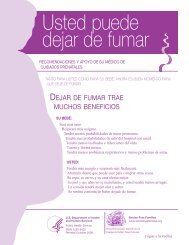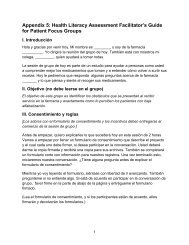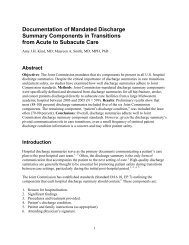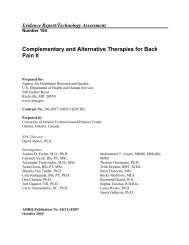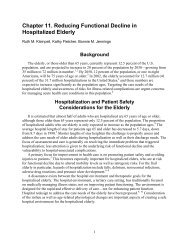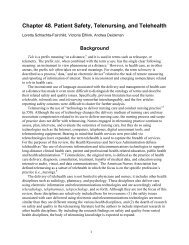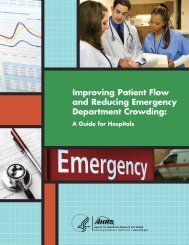Improving Patient Safety in Nursing Homes - Agency for Healthcare ...
Improving Patient Safety in Nursing Homes - Agency for Healthcare ...
Improving Patient Safety in Nursing Homes - Agency for Healthcare ...
Create successful ePaper yourself
Turn your PDF publications into a flip-book with our unique Google optimized e-Paper software.
<strong>Improv<strong>in</strong>g</strong> <strong>Patient</strong> <strong>Safety</strong> <strong>in</strong> Nurs<strong>in</strong>g <strong>Homes</strong>: A Resource List <strong>for</strong><br />
Users of the AHRQ Nurs<strong>in</strong>g Home Survey on <strong>Patient</strong> <strong>Safety</strong><br />
Culture<br />
Purpose<br />
This document conta<strong>in</strong>s references to Web sites that provide practical resources nurs<strong>in</strong>g homes can<br />
use to implement changes to improve patient safety culture and patient safety. This resource list is<br />
not exhaustive, but is provided to give <strong>in</strong>itial guidance to nurs<strong>in</strong>g homes look<strong>in</strong>g <strong>for</strong> <strong>in</strong><strong>for</strong>mation<br />
about patient safety <strong>in</strong>itiatives. This document will be updated periodically.<br />
How To Use This Resource List<br />
General resources are listed first, <strong>in</strong> alphabetical order, followed by resources organized by the<br />
dimensions assessed <strong>in</strong> the <strong>Agency</strong> <strong>for</strong> <strong>Healthcare</strong> Research and Quality (AHRQ) Nurs<strong>in</strong>g Home<br />
Survey on <strong>Patient</strong> <strong>Safety</strong> Culture (available at http://www.ahrq.gov/qual/patientsafetyculture).<br />
For easy access to the resources, keep the file open rather than pr<strong>in</strong>t<strong>in</strong>g it <strong>in</strong> hard copy because the<br />
Web site URLs are hyperl<strong>in</strong>ked and cross-referenced resources are bookmarked with<strong>in</strong> the document.<br />
NOTE: The resources <strong>in</strong>cluded <strong>in</strong> this document do not constitute an endorsement by the U.S.<br />
Department of Health and Human Services (HHS), the <strong>Agency</strong> <strong>for</strong> <strong>Healthcare</strong> Research and Quality<br />
(AHRQ), or any of their employees. HHS does not attest to the accuracy of <strong>in</strong><strong>for</strong>mation provided by<br />
l<strong>in</strong>ked sites.<br />
Suggestions <strong>for</strong> tools you would like added to the list, questions about the survey, or requests <strong>for</strong><br />
assistance can be addressed to: <strong>Safety</strong>CultureSurveys@ahrq.hhs.gov.<br />
Prepared by Westat under contract number HHSA 290200710024C <strong>for</strong> the <strong>Agency</strong> <strong>for</strong> <strong>Healthcare</strong><br />
Research and Quality.<br />
AHRQ Publication No. 11-0012-1-EF<br />
June 2010
Contents<br />
General Resources ...........................................................................................................................1<br />
Resources by Dimension..................................................................................................................9<br />
Dimension 1. Overall Perceptions of Resident <strong>Safety</strong> ...............................................................9<br />
Dimension 2. Feedback & Communication About Incidents ..................................................10<br />
Dimension 3. Supervisor Expectations and Actions Promot<strong>in</strong>g Resident <strong>Safety</strong> &<br />
Dimension 4. Management Support <strong>for</strong> Resident <strong>Safety</strong>...................................................11<br />
Dimension 5. Organizational Learn<strong>in</strong>g ....................................................................................11<br />
Dimension 6. Tra<strong>in</strong><strong>in</strong>g & Skills ...............................................................................................13<br />
Dimension 7. Compliance with Procedures .............................................................................13<br />
Dimension 8. Teamwork ..........................................................................................................14<br />
Dimension 9. Handoffs ............................................................................................................15<br />
Dimension 10. Communication Openness ...............................................................................16<br />
Dimension 11. Nonpunitive Response to Mistakes .................................................................17<br />
Dimension 12. Staff<strong>in</strong>g ............................................................................................................17<br />
ii
Alphabetical Index of Resources<br />
2010 Long Term Care National <strong>Patient</strong> <strong>Safety</strong> Goals<br />
30 Safe Practices <strong>for</strong> Better Health Care Fact Sheet<br />
Advanc<strong>in</strong>g Excellence <strong>in</strong> America's Nurs<strong>in</strong>g <strong>Homes</strong><br />
AHRQ Health Care Innovations Exchange<br />
AHRQ Health Care Innovations Exchange Learn & Network<br />
AHRQ Medical Errors and <strong>Patient</strong> <strong>Safety</strong><br />
AHRQ <strong>Patient</strong> <strong>Safety</strong> Network<br />
Appo<strong>in</strong>t a <strong>Safety</strong> Champion <strong>for</strong> Every Unit<br />
Arizona Hospital and <strong>Healthcare</strong> Association SBAR Communication<br />
Basic <strong>Patient</strong> <strong>Safety</strong> Program Resource Guide <strong>for</strong> ―Gett<strong>in</strong>g Started‖<br />
Best Practice Intervention Tools <strong>for</strong> Fall Prevention<br />
Braden Scale <strong>for</strong> Predict<strong>in</strong>g Pressure Sore Risk<br />
CAHPS Nurs<strong>in</strong>g Home Surveys<br />
Centers <strong>for</strong> Medicare and Medicaid Services (CMS): Nurs<strong>in</strong>g <strong>Homes</strong><br />
Chas<strong>in</strong>g Zero: W<strong>in</strong>n<strong>in</strong>g The War On <strong>Healthcare</strong> Harm<br />
Commonwealth Fund<br />
Conduct <strong>Patient</strong> <strong>Safety</strong> Leadership WalkRounds <br />
Conduct <strong>Safety</strong> Brief<strong>in</strong>gs<br />
Consumers Advanc<strong>in</strong>g <strong>Patient</strong> <strong>Safety</strong><br />
Cooperative Network Improves <strong>Patient</strong> Transactions Between Hospitals and Skilled Nurs<strong>in</strong>g<br />
Facilities, Reduc<strong>in</strong>g Readmissions and Length of Hospital Stay<br />
Creation of Households Program <strong>in</strong> Nurs<strong>in</strong>g Home Improves Residents’ Health Status, Reduces<br />
Staff Turnover, and Boosts Demand <strong>for</strong> Services<br />
Decision Tree <strong>for</strong> Unsafe Acts Culpability<br />
Department of Defense <strong>Patient</strong> <strong>Safety</strong> Program<br />
Enhanced Toilet<strong>in</strong>g Program Reduces Incont<strong>in</strong>ence and Its Comorbidities Among Residents of<br />
Long-Term Care Facility<br />
Error Proof<strong>in</strong>g<br />
Facility Assessment: Checklists <strong>for</strong> Activities of Daily Liv<strong>in</strong>g<br />
Facility Assessment: Checklists <strong>for</strong> Delirium<br />
Falls <strong>in</strong> Nurs<strong>in</strong>g <strong>Homes</strong> Fact Sheet<br />
Falls Management Program<br />
Fax Back Sheet<br />
Handoff of Care Frequently Asked Questions<br />
Home-Like, Self-Directed Environment Provides Superior Quality of Life Than <strong>in</strong> Traditional<br />
Nurs<strong>in</strong>g <strong>Homes</strong> and Assisted Liv<strong>in</strong>g Facilities<br />
Immunizations Toolkit<br />
<strong>Improv<strong>in</strong>g</strong> Resident <strong>Safety</strong> <strong>in</strong> Long-term Care Facilities<br />
Institute <strong>for</strong> <strong>Healthcare</strong> Improvement<br />
Institute <strong>for</strong> <strong>Healthcare</strong> Improvement: Plan-Do-Study-Act (PDSA) Worksheet (IHI Tool)<br />
Institute <strong>for</strong> Safe Medication Practices<br />
Interdiscipl<strong>in</strong>ary Team Identifies and Addresses Risk Factors <strong>for</strong> Falls Among Nurs<strong>in</strong>g Home<br />
Residents, Lead<strong>in</strong>g to Fewer Falls and Less Use of Restra<strong>in</strong>ts<br />
Jo<strong>in</strong>t Commission: <strong>Patient</strong> <strong>Safety</strong><br />
iii
Limit<strong>in</strong>g Physical Restra<strong>in</strong>t Use<br />
Mak<strong>in</strong>g Health Care Safer: A Critical Analysis of <strong>Patient</strong> <strong>Safety</strong> Practices<br />
Medication Reconciliation Toolkit<br />
Medications At Transitions and Cl<strong>in</strong>ical Handoffs (MATCH) Initiative<br />
Mistake-Proof<strong>in</strong>g the Design of Health Care Processes<br />
National Center <strong>for</strong> <strong>Patient</strong> <strong>Safety</strong><br />
National <strong>Patient</strong> <strong>Safety</strong> Foundation<br />
National Quality Forum<br />
Nonpunitive Response to Error: The Fair and Just Pr<strong>in</strong>ciples of the Aurora Health Care Culture<br />
Nurs<strong>in</strong>g Home ―Neighborhoods‖ Emphasize Dignity and Independence, Lead<strong>in</strong>g to<br />
Improvements <strong>in</strong> Resident Health and Quality of Life and Lower Employee Turnover<br />
Nurs<strong>in</strong>g Home Improvement Feedback Tool<br />
Nurs<strong>in</strong>g Home Learn<strong>in</strong>g Collaborative Improves Quality of Care, Reduces Staff Turnover<br />
Nutrition Care Alerts: Warn<strong>in</strong>g Signs and Action Steps <strong>for</strong> Caregivers <strong>in</strong> Nurs<strong>in</strong>g Facilities<br />
On-Time Quality Improvement <strong>for</strong> Long-Term Care<br />
<strong>Patient</strong> <strong>Safety</strong> and the "Just Culture": A Primer <strong>for</strong> Health Care Executives<br />
<strong>Patient</strong> <strong>Safety</strong> and the ―Just Culture‖: A Presentation by David Marx, JD<br />
<strong>Patient</strong> <strong>Safety</strong> Primer: Root Cause Analysis<br />
<strong>Patient</strong> <strong>Safety</strong> Primer: <strong>Safety</strong> Culture<br />
<strong>Patient</strong> <strong>Safety</strong> Primer: Teamwork Tra<strong>in</strong><strong>in</strong>g<br />
<strong>Patient</strong> <strong>Safety</strong> Round<strong>in</strong>g Toolkit<br />
<strong>Patient</strong> <strong>Safety</strong> Through Teamwork and Communication Toolkit<br />
Pennsylvania <strong>Patient</strong> <strong>Safety</strong> Authority<br />
Plann<strong>in</strong>g <strong>for</strong> Your Discharge: A Checklist <strong>for</strong> <strong>Patient</strong>s and Caregivers Prepar<strong>in</strong>g to Leave a<br />
Hospital, Nurs<strong>in</strong>g Home, or Other Health Care Sett<strong>in</strong>g<br />
Post-Acute Transfer Form<br />
Prevention and Treatment Program Integrates Actionable Reports Into Practice, Significantly<br />
Reduc<strong>in</strong>g Pressure Ulcers <strong>in</strong> Nurs<strong>in</strong>g Home Residents<br />
Provide Feedback to Frontl<strong>in</strong>e Staff<br />
SBAR Technique <strong>for</strong> Communication: A Situational Brief<strong>in</strong>g Model<br />
Staff Tra<strong>in</strong><strong>in</strong>g and Support, Incentives, and Feedback Fails to Generate Susta<strong>in</strong>able Reductions<br />
<strong>in</strong> Pressure Ulcers at Nurs<strong>in</strong>g Home<br />
Studer Group Toolkit: <strong>Patient</strong> <strong>Safety</strong><br />
Systems Approach to Quality Improvement <strong>in</strong> Long-Term Care: Safe Medication Practices<br />
TeamSTEPPS - Team Strategies and Tools to Enhance Per<strong>for</strong>mance and <strong>Patient</strong> <strong>Safety</strong><br />
Try This: Best Practices <strong>in</strong> Nurs<strong>in</strong>g Care to Older Adults<br />
United States Department of Veteran Affairs National Center <strong>for</strong> <strong>Patient</strong> <strong>Safety</strong> 2004 Falls<br />
Toolkit<br />
VA National Center <strong>for</strong> <strong>Patient</strong> <strong>Safety</strong> – NCPS Root Cause Analysis Tool<br />
WHO Collaborat<strong>in</strong>g Centre <strong>for</strong> <strong>Patient</strong> <strong>Safety</strong> Solutions<br />
Will It Work Here?: A Decisionmaker’s Guide to Adopt<strong>in</strong>g Innovations<br />
Work<strong>for</strong>ce Retention <strong>in</strong> Long-term Care: What a difference management makes<br />
iv
General Resources<br />
1. 2010 Long Term Care National <strong>Patient</strong> <strong>Safety</strong> Goals<br />
http://www.jo<strong>in</strong>tcommission.org/patientsafety/nationalpatientsafetygoals/<br />
The purpose of The Jo<strong>in</strong>t Commission Long Term Care National <strong>Patient</strong> <strong>Safety</strong> Goals is to<br />
improve patient safety <strong>in</strong> a long-term care sett<strong>in</strong>g by focus<strong>in</strong>g on specific goals. This Web<br />
site conta<strong>in</strong>s a l<strong>in</strong>k to the latest goals, which <strong>in</strong>clude improvements emanat<strong>in</strong>g from the<br />
Standards Improvement Initiative. In addition, the site has <strong>in</strong><strong>for</strong>mation on the new<br />
number<strong>in</strong>g system and m<strong>in</strong>or language changes <strong>for</strong> consistency.<br />
2. 30 Safe Practices <strong>for</strong> Better Health Care Fact Sheet<br />
http://<strong>in</strong>novations.ahrq.gov/content.aspx?id=765<br />
This fact sheet is featured on the <strong>Agency</strong> <strong>for</strong> <strong>Healthcare</strong> Research and Quality’s Health Care<br />
Innovations Exchange. The National Quality Forum has identified 30 safe practices that<br />
evidence shows can work to reduce or prevent adverse events and medication errors. These<br />
practices can be universally adopted by all health care sett<strong>in</strong>gs to reduce the risk of harm to<br />
patients. This tool also provides background <strong>in</strong><strong>for</strong>mation about the National Quality Forum,<br />
as well as l<strong>in</strong>ks to a report provid<strong>in</strong>g more detailed <strong>in</strong><strong>for</strong>mation about the 30 Safe Practices.<br />
Advanc<strong>in</strong>g Excellence <strong>in</strong> America’s Nurs<strong>in</strong>g <strong>Homes</strong><br />
http://www.nhqualitycampaign.org/star_<strong>in</strong>dex.aspx?controls=welcome<br />
Advanc<strong>in</strong>g Excellence <strong>in</strong> America’s Nurs<strong>in</strong>g <strong>Homes</strong> is an ongo<strong>in</strong>g coalition-based campaign<br />
concerned with how we care <strong>for</strong> older adults, chronically ill and disabled people, and people<br />
recuperat<strong>in</strong>g <strong>in</strong> a nurs<strong>in</strong>g home environment. This voluntary campaign monitors key<br />
<strong>in</strong>dicators of nurs<strong>in</strong>g home care quality, both cl<strong>in</strong>ical quality and organizational improvement<br />
goals; promotes excellence <strong>in</strong> caregiv<strong>in</strong>g; acknowledges the critical role nurs<strong>in</strong>g home staff<br />
have <strong>in</strong> provid<strong>in</strong>g care; and recognizes the important role of consumers <strong>in</strong> contribut<strong>in</strong>g ideas<br />
and suggestions to the campaign.<br />
3. AHRQ Health Care Innovations Exchange<br />
http://www.<strong>in</strong>novations.ahrq.gov/<br />
The <strong>Agency</strong> <strong>for</strong> <strong>Healthcare</strong> Research and Quality’s Health Care Innovations Exchange is a<br />
comprehensive program designed to accelerate the development and adoption of <strong>in</strong>novations<br />
<strong>in</strong> health care delivery. This program supports AHRQ’s mission to improve the safety,<br />
effectiveness, patient centeredness, timel<strong>in</strong>ess, efficiency, and equity of care, with a<br />
particular emphasis on reduc<strong>in</strong>g disparities <strong>in</strong> health care and health among racial, ethnic,<br />
and socioeconomic groups. The Innovations Exchange has the follow<strong>in</strong>g components:<br />
� Searchable <strong>in</strong>novations and attempts<br />
� Searchable QualityTools<br />
� Learn<strong>in</strong>g opportunities<br />
� Network<strong>in</strong>g opportunities<br />
1
4. AHRQ Medical Errors and <strong>Patient</strong> <strong>Safety</strong><br />
http://www.ahrq.gov/qual/errorsix.htm<br />
The <strong>Agency</strong> <strong>for</strong> <strong>Healthcare</strong> Research and Quality Medical Errors and <strong>Patient</strong> <strong>Safety</strong> Web site<br />
provides l<strong>in</strong>ks to various resources and tools <strong>for</strong> promot<strong>in</strong>g patient safety <strong>in</strong> the follow<strong>in</strong>g<br />
categories:<br />
� Tips <strong>for</strong> Consumers and <strong>Patient</strong>s<br />
� Background<br />
� Communication and Teamwork<br />
� Design and Work<strong>in</strong>g Conditions<br />
� Implementation and Trans<strong>for</strong>mation<br />
� <strong>Patient</strong> <strong>Safety</strong> Organizations<br />
� <strong>Patient</strong> <strong>Safety</strong> Research and Fund<strong>in</strong>g Opportunities<br />
� Tools and Techniques<br />
5. AHRQ <strong>Patient</strong> <strong>Safety</strong> Network<br />
http://www.psnet.ahrq.gov/<br />
The <strong>Patient</strong> <strong>Safety</strong> Network (PSNet) is a national Web-based resource featur<strong>in</strong>g the latest<br />
news and essential resources on patient safety. The site offers weekly updates of patient<br />
safety literature, news, tools, and meet<strong>in</strong>gs (―What’s New‖), and a vast set of carefully<br />
annotated l<strong>in</strong>ks to important research and other <strong>in</strong><strong>for</strong>mation on patient safety (―The<br />
Collection‖). Supported by a robust patient safety taxonomy and Web architecture, AHRQ<br />
PSNet provides powerful search<strong>in</strong>g and brows<strong>in</strong>g capability, as well as the ability <strong>for</strong> diverse<br />
users to customize the site around their <strong>in</strong>terests (My PSNet). It also is tightly coupled with<br />
AHRQ WebM&M, the popular monthly journal that features user-submitted cases of medical<br />
errors, expert commentaries, and perspectives on patient safety.<br />
6. CAHPS® Nurs<strong>in</strong>g Home Surveys<br />
http://www.cahps.ahrq.gov/content/products/NH/PROD_NH_Intro.asp<br />
The Consumer Assessment of <strong>Healthcare</strong> Providers and Systems (CAHPS®) program is a<br />
multiyear AHRQ <strong>in</strong>itiative. This Web site provides <strong>in</strong><strong>for</strong>mation on the CAHPS Nurs<strong>in</strong>g<br />
Home Surveys, as well as l<strong>in</strong>ks to three separate <strong>in</strong>struments: an <strong>in</strong>-person questionnaire <strong>for</strong><br />
long-term residents, a mail questionnaire <strong>for</strong> recently discharged short-stay residents, and a<br />
questionnaire <strong>for</strong> residents’ family members.<br />
7. Centers <strong>for</strong> Medicare & Medicaid Services (CMS): Nurs<strong>in</strong>g <strong>Homes</strong><br />
http://www.cms.hhs.gov/CertificationandComplianc/12_NHs.asp<br />
This page provides basic <strong>in</strong><strong>for</strong>mation about be<strong>in</strong>g certified as a Medicare or Medicaid<br />
nurs<strong>in</strong>g home provider and <strong>in</strong>cludes l<strong>in</strong>ks to applicable laws, regulations, and compliance<br />
<strong>in</strong><strong>for</strong>mation. The site also has related nurs<strong>in</strong>g home reports, compendia, and a list of special<br />
focus facilities (i.e., nurs<strong>in</strong>g homes with a record of poor survey [<strong>in</strong>spection] per<strong>for</strong>mance on<br />
which CMS focuses extra attention) available <strong>for</strong> download.<br />
2
8. Chas<strong>in</strong>g Zero: W<strong>in</strong>n<strong>in</strong>g The War On <strong>Healthcare</strong> Harm<br />
http://discoveryhealthcme.discovery.com/zero/media/program.html<br />
A near-fatal medical error almost cost the lives of tw<strong>in</strong>s born to actor Dennis Quaid and his<br />
wife. This real-life event <strong>in</strong>spires a new patient education documentary featur<strong>in</strong>g the Quaid<br />
family’s personal ordeal, along with stories of other families who faced medical errors. It<br />
also features experts who are lead<strong>in</strong>g ef<strong>for</strong>ts to help health care providers reduce medical<br />
errors and improve patient safety outcomes.<br />
9. The Commonwealth Fund<br />
http://www.commonwealthfund.org/<br />
The Commonwealth Fund is a private foundation that aims to promote a high-per<strong>for</strong>m<strong>in</strong>g<br />
health care system that achieves better access, improved quality, and greater efficiency.<br />
Ef<strong>for</strong>ts are aimed particularly at society's most vulnerable populations, <strong>in</strong>clud<strong>in</strong>g low-<strong>in</strong>come<br />
people, un<strong>in</strong>sured people, racial and ethnic m<strong>in</strong>ority groups, young children, and older adults.<br />
The Commonwealth Fund provides <strong>in</strong><strong>for</strong>mation on a variety of health care topics, free<br />
publications, and <strong>in</strong>novations and tools <strong>for</strong> improv<strong>in</strong>g health care.<br />
10. Consumers Advanc<strong>in</strong>g <strong>Patient</strong> <strong>Safety</strong><br />
http://www.patientsafety.org/<br />
Consumers Advanc<strong>in</strong>g <strong>Patient</strong> <strong>Safety</strong> (CAPS) is a consumer-led nonprofit organization<br />
aimed at provid<strong>in</strong>g a collective voice <strong>for</strong> <strong>in</strong>dividuals, families, and healers who want to<br />
prevent harm <strong>in</strong> health care encounters through partnership and collaboration. CAPS features<br />
a transitions toolkit (available at http://www.patientsafety.org/page/142046/) titled ―Tak<strong>in</strong>g<br />
Charge of Your <strong>Healthcare</strong>: Your Path to Be<strong>in</strong>g an Empowered <strong>Patient</strong>.‖<br />
11. Department of Defense <strong>Patient</strong> <strong>Safety</strong> Program<br />
http://health.mil/dodpatientsafety<br />
The Department of Defense <strong>Patient</strong> <strong>Safety</strong> Program is a comprehensive program designed to<br />
establish a culture of patient safety and quality with<strong>in</strong> the Military Health System (MHS).<br />
The program encourages a systems approach to create a safer patient environment; engages<br />
MHS leadership; promotes collaboration across all three Services; and fosters trust,<br />
transparency, teamwork, and communication.<br />
12. Enhanced Toilet<strong>in</strong>g Program Reduces Incont<strong>in</strong>ence and Its Comorbidities Among<br />
Residents of Long-Term Care Facility<br />
http://www.<strong>in</strong>novations.ahrq.gov/content.aspx?id=2245<br />
This featured profile is available on the AHRQ Health Care Innovations Exchange Web site.<br />
A long-term care facility adopted an enhanced toilet<strong>in</strong>g program consist<strong>in</strong>g of the follow<strong>in</strong>g<br />
components: <strong>in</strong>dividualized toilet<strong>in</strong>g plan of care based on periodic resident assessments,<br />
revised and new care documentation tools, devices to assist with toilet<strong>in</strong>g, and<br />
comprehensive education and tra<strong>in</strong><strong>in</strong>g <strong>for</strong> facility staff. The program led to a sharp decl<strong>in</strong>e <strong>in</strong><br />
the prevalence of <strong>in</strong>cont<strong>in</strong>ence (from 76 to 38 percent of residents) and <strong>in</strong> associated<br />
comorbidities and staff <strong>in</strong>juries.<br />
3
13. Facility Assessment: Checklists <strong>for</strong> Activities of Daily Liv<strong>in</strong>g<br />
http://www.<strong>in</strong>novations.ahrq.gov/content.aspx?id=1657<br />
This 11-page quality tool is featured on the AHRQ Health Care Innovations Exchange Web<br />
site. It provides self-assessment checklists <strong>for</strong> nurs<strong>in</strong>g home staff to use <strong>in</strong> assess<strong>in</strong>g<br />
processes related to decl<strong>in</strong>es <strong>in</strong> activities of daily liv<strong>in</strong>g (ADL) among facility residents, <strong>in</strong><br />
order to identify areas that need improvement. These checklists focus primarily on<br />
issues related to the ―late-loss‖ ADLs of transfers, toilet-use, bed mobility, and eat<strong>in</strong>g. This<br />
tool <strong>in</strong>cludes checklists on the follow<strong>in</strong>g ADL-related topics: screen<strong>in</strong>g <strong>for</strong> ADL function<br />
and decl<strong>in</strong>e, assessment, care plans, monitor<strong>in</strong>g and reassessment of ADL function, and staff<br />
education and tra<strong>in</strong><strong>in</strong>g.<br />
14. Facility Assessment: Checklists <strong>for</strong> Delirium<br />
http://www.<strong>in</strong>novations.ahrq.gov/content.aspx?id=1665<br />
This 11-page quality tool is featured on the AHRQ Health Care Innovations Exchange Web<br />
site. It provides self-assessment checklists <strong>for</strong> nurs<strong>in</strong>g home staff to use <strong>in</strong> assess<strong>in</strong>g<br />
processes related to delirium <strong>in</strong> the facility, <strong>in</strong> order to identify areas that need improvement.<br />
This tool <strong>in</strong>cludes checklists on the follow<strong>in</strong>g delirium-related topics: delirium assessment,<br />
delirium care plans, delirium screen<strong>in</strong>g, and staff education and tra<strong>in</strong><strong>in</strong>g.<br />
15. Home-Like, Self-Directed Environment Provides Superior Quality of Life Than <strong>in</strong><br />
Traditional Nurs<strong>in</strong>g <strong>Homes</strong> and Assisted Liv<strong>in</strong>g Facilities<br />
http://www.<strong>in</strong>novations.ahrq.gov/content.aspx?id=1857<br />
This featured profile is available on the AHRQ Health Care Innovations Exchange Web site.<br />
THE GREEN HOUSE ® model provides older adults with an alternative to nurs<strong>in</strong>g homes<br />
and traditional assisted liv<strong>in</strong>g facilities. These communities provide groups of 7 to 10 older<br />
adults a com<strong>for</strong>table, warm, home environment and staff who provide the highest level of<br />
cl<strong>in</strong>ical care while nurtur<strong>in</strong>g relationships and older adults’ autonomy. A 30-month<br />
evaluation suggests that THE GREEN HOUSE ® adults receive equal or higher quality<br />
of care and report better quality of life than residents of nurs<strong>in</strong>g homes.<br />
16. Immunizations Toolkit<br />
http://www.<strong>in</strong>novations.ahrq.gov/content.aspx?id=1684<br />
This toolkit is featured on the AHRQ Health Care Innovations Exchange Web site. It was<br />
developed to <strong>in</strong>crease immunization rates among nurs<strong>in</strong>g home residents and staff. It<br />
offers specific <strong>in</strong><strong>for</strong>mation and education on the benefits of <strong>in</strong>fluenza (flu) and pneumonia<br />
immunization, as well as sample guidel<strong>in</strong>es and tools needed to run an effective and<br />
susta<strong>in</strong>able resident and staff immunization program.<br />
4
17. Institute <strong>for</strong> <strong>Healthcare</strong> Improvement<br />
http://www.ihi.org/ihi<br />
The Institute <strong>for</strong> <strong>Healthcare</strong> Improvement is a reliable source of energy, knowledge, and<br />
support <strong>for</strong> a never-end<strong>in</strong>g campaign to improve health care worldwide. The <strong>in</strong>stitute helps<br />
accelerate change <strong>in</strong> health care by cultivat<strong>in</strong>g promis<strong>in</strong>g concepts <strong>for</strong> improv<strong>in</strong>g patient care<br />
and turn<strong>in</strong>g those ideas <strong>in</strong>to action.<br />
18. Institute <strong>for</strong> Safe Medication Practices<br />
http://www.ismp.org<br />
The Institute <strong>for</strong> Safe Medication Practices offers a wide variety of free educational materials<br />
and services on their Web site:<br />
� Special Medication Hazard Alerts<br />
� Searchable <strong>in</strong><strong>for</strong>mation on a wide variety of medication safety topics<br />
� Answers to Frequently Asked Questions about medication safety<br />
� Food and Drug Adm<strong>in</strong>istration <strong>Patient</strong> <strong>Safety</strong> Videos<br />
� Pathways <strong>for</strong> Medication <strong>Safety</strong> Tools<br />
� White papers on bar-cod<strong>in</strong>g technology and electronic prescrib<strong>in</strong>g<br />
� A monitored Message Board to share questions, answers, and ideas<br />
19. The Jo<strong>in</strong>t Commission: <strong>Patient</strong> <strong>Safety</strong><br />
http://www.jo<strong>in</strong>tcommission.org/<strong>Patient</strong><strong>Safety</strong>/<br />
The <strong>Patient</strong> <strong>Safety</strong> pages on The Jo<strong>in</strong>t Commission Web site offer <strong>in</strong><strong>for</strong>mation on patient<br />
safety-related standards, the National <strong>Patient</strong> <strong>Safety</strong> Goals, the Speak Up <strong>in</strong>itiatives (a<br />
national program urg<strong>in</strong>g patients to become active participants on their health care team), and<br />
other resources.<br />
20. National Center <strong>for</strong> <strong>Patient</strong> <strong>Safety</strong><br />
http://www.patientsafety.gov<br />
The National Center <strong>for</strong> <strong>Patient</strong> <strong>Safety</strong> (NCPS) was established <strong>in</strong> 1999 to develop and<br />
nurture a culture of safety throughout the Department of Veterans Affairs. The primary<br />
<strong>in</strong>tended audience <strong>for</strong> the public Web site is health care professionals and health care<br />
adm<strong>in</strong>istrators.<br />
21. National <strong>Patient</strong> <strong>Safety</strong> Foundation®<br />
http://www.npsf.org/<br />
The National <strong>Patient</strong> <strong>Safety</strong> Foundation ® has been pursu<strong>in</strong>g one mission s<strong>in</strong>ce its found<strong>in</strong>g <strong>in</strong><br />
1997 – to improve the safety of the health care system <strong>for</strong> the patients and families it serves.<br />
NPSF is unwaver<strong>in</strong>g <strong>in</strong> its determ<strong>in</strong>ed and committed focus on unit<strong>in</strong>g discipl<strong>in</strong>es and<br />
organizations across the cont<strong>in</strong>uum of care, champion<strong>in</strong>g a collaborative, <strong>in</strong>clusive,<br />
multistakeholder approach.<br />
5
22. National Quality Forum<br />
http://www.quality<strong>for</strong>um.org/Topics/<strong>Safety</strong>.aspx<br />
The National Quality Forum (NQF) is a nonprofit organization that aims to improve the<br />
quality of health care <strong>for</strong> all Americans through fulfillment of its three-part mission:<br />
� Sett<strong>in</strong>g national priorities and goals <strong>for</strong> per<strong>for</strong>mance improvement;<br />
� Endors<strong>in</strong>g national consensus standards <strong>for</strong> measur<strong>in</strong>g and publicly report<strong>in</strong>g on<br />
per<strong>for</strong>mance; and<br />
� Promot<strong>in</strong>g the atta<strong>in</strong>ment of national goals through education and outreach programs.<br />
23. Nurs<strong>in</strong>g Home “Neighborhoods” Emphasize Dignity and Independence, Lead<strong>in</strong>g to<br />
Improvements <strong>in</strong> Resident Health and Quality of Life and Lower Employee Turnover<br />
http://www.<strong>in</strong>novations.ahrq.gov/content.aspx?id=1906<br />
This featured profile is available on the AHRQ Health Care Innovations Exchange Web site.<br />
Providence Mount St. V<strong>in</strong>cent (known as ―The Mount‖) developed and implemented a new<br />
model <strong>for</strong> nurs<strong>in</strong>g home care <strong>in</strong> which most residents live <strong>in</strong> a ―neighborhood‖ of 20 to 23<br />
residents conta<strong>in</strong><strong>in</strong>g a cluster of private and semiprivate rooms and a large kitchen/d<strong>in</strong><strong>in</strong>g<br />
area that serves as the central gather<strong>in</strong>g spot <strong>for</strong> meals and activities. The Mount’s approach<br />
also focuses on giv<strong>in</strong>g residents more <strong>in</strong>dependence, autonomy, and dignity than <strong>in</strong> a<br />
traditional nurs<strong>in</strong>g home, lead<strong>in</strong>g to a greater sense of community and a higher quality of life<br />
<strong>for</strong> residents, as well as a better work environment <strong>for</strong> employees.<br />
24. Nutrition Care Alerts: Warn<strong>in</strong>g Signs and Action Steps <strong>for</strong> Caregivers <strong>in</strong> Nurs<strong>in</strong>g<br />
Facilities<br />
http://www.<strong>in</strong>novations.ahrq.gov/content.aspx?id=288<br />
This featured profile is available on the AHRQ Health Care Innovations Exchange Web site.<br />
This guide, developed by nutrition and long-term care experts, can help caregivers of nurs<strong>in</strong>g<br />
home residents learn more about the warn<strong>in</strong>g signs of poor nutrition and practical steps to<br />
ma<strong>in</strong>ta<strong>in</strong> and improve residents’ nutritional health. Warn<strong>in</strong>g signs <strong>in</strong>clude un<strong>in</strong>tended weight<br />
loss, dehydration, pressure ulcers, and complications from tube feed<strong>in</strong>g.<br />
25. Pennsylvania <strong>Patient</strong> <strong>Safety</strong> Authority<br />
http://www.patientsafetyauthority.org/Pages/Default.aspx<br />
The Pennsylvania <strong>Patient</strong> <strong>Safety</strong> Authority is charged with tak<strong>in</strong>g steps to reduce and<br />
elim<strong>in</strong>ate medical errors by identify<strong>in</strong>g problems and recommend<strong>in</strong>g solutions that promote<br />
patient safety <strong>in</strong> various health care sett<strong>in</strong>gs. The Web site features current patient safety<br />
articles and highlights patient safety <strong>in</strong>itiatives and tools. Users can browse by care sett<strong>in</strong>g,<br />
event (e.g., falls, medication errors), discipl<strong>in</strong>e, audience, and patient safety focus.<br />
26. WHO Collaborat<strong>in</strong>g Centre <strong>for</strong> <strong>Patient</strong> <strong>Safety</strong> Solutions<br />
http://www.cc<strong>for</strong>patientsafety.org/patient-safety-solutions<br />
The Jo<strong>in</strong>t Commission, Jo<strong>in</strong>t Commission International, and World Health Organization host<br />
a center <strong>for</strong> patient safety solutions. This Web site provides <strong>in</strong><strong>for</strong>mation about n<strong>in</strong>e solutions<br />
6
<strong>for</strong> improv<strong>in</strong>g patient safety approved by the International Steer<strong>in</strong>g Committee. Solutions<br />
<strong>in</strong>clude: (1) Look-Alike, Sound-Alike Medication Names, (2) <strong>Patient</strong> Identification, (3)<br />
Communication Dur<strong>in</strong>g <strong>Patient</strong> Hand-Overs, (4) Per<strong>for</strong>mance of Correct Procedure at<br />
Correct Body Site, (5) Control of Concentrated Electrolyte Solutions, (6) Assur<strong>in</strong>g<br />
Medication Accuracy at Transitions <strong>in</strong> Care, (7) Avoid<strong>in</strong>g Catheter and Tub<strong>in</strong>g Mis-<br />
Connections, (8) S<strong>in</strong>gle Use of Injection Devices, and (9) Improved Hand Hygiene to<br />
Prevent Health Care-Associated Infection.<br />
Falls Management/Prevention<br />
1. Falls <strong>in</strong> Nurs<strong>in</strong>g <strong>Homes</strong> Fact Sheet<br />
http://www.premier<strong>in</strong>c.com/safety/topics/falls/downloads/E-02-falls-nurs<strong>in</strong>g-homes.doc<br />
This fact sheet identifies the problem of falls <strong>in</strong> nurs<strong>in</strong>g homes and offers strategies <strong>for</strong><br />
prevent<strong>in</strong>g falls.<br />
2. Falls Management Program<br />
http://www.qualitynet.org/dcs/ContentServer?cid=1136495771104&pagename=Medqic/MQ<br />
Tools/ToolTemplate&c=MQTools<br />
This <strong>in</strong>terdiscipl<strong>in</strong>ary program available <strong>for</strong> download from QualityNet. It is designed to<br />
assist nurs<strong>in</strong>g facilities <strong>in</strong> improv<strong>in</strong>g their fall care processes and outcomes through<br />
educational and quality improvement tools.<br />
3. Interdiscipl<strong>in</strong>ary Team Identifies and Addresses Risk Factors <strong>for</strong> Falls Among Nurs<strong>in</strong>g<br />
Home Residents, Lead<strong>in</strong>g to Fewer Falls and Less Use of Restra<strong>in</strong>ts<br />
http://www.<strong>in</strong>novations.ahrq.gov/content.aspx?id=1835<br />
This featured profile is available on the AHRQ Innovations Exchange Web site. Ethica<br />
Health and Retirement Communities has developed a falls management program, the<br />
cornerstone of which is an <strong>in</strong>terdiscipl<strong>in</strong>ary ―falls team‖ at each nurs<strong>in</strong>g home that<br />
regularly assesses residents <strong>for</strong> their risk of fall<strong>in</strong>g and develops <strong>in</strong>tervention plans <strong>for</strong> those<br />
found to be at high risk. The team also documents and <strong>in</strong>vestigates every fall and takes steps<br />
to reduce the chance of recurrence. The program led to a slight decl<strong>in</strong>e <strong>in</strong> falls and a large<br />
reduction <strong>in</strong> use of restra<strong>in</strong>ts.<br />
4. Limit<strong>in</strong>g Physical Restra<strong>in</strong>t Use<br />
http://www.primaris.org/Physical%20Restra<strong>in</strong>ts<br />
Primaris and a group of Missouri nurs<strong>in</strong>g homes collaborated on a 3-year project to reduce<br />
the use of physical restra<strong>in</strong>ts. This Web site provides background <strong>in</strong><strong>for</strong>mation on restra<strong>in</strong>ts<br />
and free quality improvement resources on this topic, <strong>in</strong>clud<strong>in</strong>g a variety of checklists and<br />
educational materials.<br />
7
5. Department of Veteran Affairs National Center <strong>for</strong> <strong>Patient</strong> <strong>Safety</strong> 2004 Falls Toolkit<br />
http://www.va.gov/ncps/<strong>Safety</strong>Topics/fallstoolkit/<strong>in</strong>dex.html<br />
The Department of Veterans Affairs National Center <strong>for</strong> <strong>Patient</strong> <strong>Safety</strong> (NCPS) worked with<br />
the <strong>Patient</strong> <strong>Safety</strong> Center of Inquiry <strong>in</strong> Tampa, Florida, and others to develop the NCPS Falls<br />
Toolkit. The toolkit is designed to aid facilities <strong>in</strong> develop<strong>in</strong>g a comprehensive falls<br />
prevention program. This Web site conta<strong>in</strong>s l<strong>in</strong>ks to the falls notebook, media tools, and<br />
additional resources.<br />
6. Best Practice Intervention Tools <strong>for</strong> Fall Prevention<br />
http://www.<strong>in</strong>novations.ahrq.gov/content.aspx?id=2094<br />
The Best Practice Intervention Packages (BPIP) are featured on the AHRQ Health Care<br />
Innovations Exchange Web site. The packages were designed <strong>for</strong> use by any home health<br />
agency to support ef<strong>for</strong>ts to reduce avoidable acute care hospitalizations. The topic of this<br />
package is falls prevention.<br />
Reduc<strong>in</strong>g Pressure Ulcers<br />
1. Braden Scale <strong>for</strong> Predict<strong>in</strong>g Pressure Sore Risk<br />
http://www.<strong>in</strong>novations.ahrq.gov/content.aspx?id=2403<br />
This rat<strong>in</strong>g scale <strong>for</strong> nurses and other health care providers is featured on the AHRQ Health<br />
Care Innovations Exchange Web site. It predicts a patient’s level of risk <strong>for</strong> develop<strong>in</strong>g<br />
pressure ulcers. The scale is composed of six subscales that measure functional capabilities<br />
of the patient that contribute to either higher <strong>in</strong>tensity and duration of pressure or lower tissue<br />
tolerance <strong>for</strong> pressure.<br />
2. Nurs<strong>in</strong>g Home Improvement Feedback Tool<br />
http://www.<strong>in</strong>novations.ahrq.gov/content.aspx?id=2193<br />
This tool is featured on the AHRQ Health Care Innovations Exchange Web site. The Nurs<strong>in</strong>g<br />
Home Improvement Feedback Tool (NHIFT, or ―nifty‖) is a computer-based audit and<br />
feedback tool that assists nurs<strong>in</strong>g homes <strong>in</strong> collect<strong>in</strong>g data and view<strong>in</strong>g process measure<br />
scores <strong>for</strong> four cl<strong>in</strong>ical topics: depression, pa<strong>in</strong>, physical restra<strong>in</strong>ts, and pressure ulcers.<br />
3. On-Time Quality Improvement <strong>for</strong> Long-Term Care<br />
http://www.ahrq.gov/research/ontime.htm<br />
AHRQ launched a program to help frontl<strong>in</strong>e nurs<strong>in</strong>g home staff reduce the occurrence of <strong>in</strong>house<br />
pressure ulcers, provid<strong>in</strong>g residents with more efficient, effective, and patient-centered<br />
care. The On-Time Quality Improvement <strong>for</strong> Long-Term Care program is an <strong>in</strong>novative<br />
program designed to improve day-to-day practice <strong>in</strong> nurs<strong>in</strong>g homes, improve and redesign<br />
workflow, enrich work culture, and reduce pressure ulcers. This Web site conta<strong>in</strong>s program<br />
materials, a video, and read<strong>in</strong>ess and health <strong>in</strong><strong>for</strong>mation technology assessment tools<br />
available <strong>for</strong> download.<br />
8
4. Prevention and Treatment Program Integrates Actionable Reports Into Practice,<br />
Significantly Reduc<strong>in</strong>g Pressure Ulcers <strong>in</strong> Nurs<strong>in</strong>g Home Residents<br />
http://www.<strong>in</strong>novations.ahrq.gov/content.aspx?id=2153<br />
This featured profile is available on the AHRQ Health Care Innovations Exchange Web site.<br />
The On-Time Pressure Ulcer Prevention and Treatment Program uses standardized<br />
documentation data elements and actionable cl<strong>in</strong>ical reports that are <strong>in</strong>tegrated <strong>in</strong>to practice<br />
at nurs<strong>in</strong>g homes; the goal of the program is to help nurs<strong>in</strong>g home staff identify and address<br />
risk factors <strong>for</strong> pressure ulcers <strong>in</strong> residents.<br />
5. Staff Tra<strong>in</strong><strong>in</strong>g and Support, Incentives, and Feedback Fails to Generate Susta<strong>in</strong>able<br />
Reductions <strong>in</strong> Pressure Ulcers at Nurs<strong>in</strong>g Home<br />
http://www.<strong>in</strong>novations.ahrq.gov/content.aspx?id=1895<br />
This profile is available on the AHRQ Health Care Innovations Exchange Web site. Guided<br />
by a university research team, a 136-bed, not-<strong>for</strong>-profit nurs<strong>in</strong>g home <strong>in</strong> Pennsylvania<br />
implemented a quality improvement program to reduce the <strong>in</strong>cidence of pressure ulcers<br />
(PUs). The program had three components: <strong>in</strong>creas<strong>in</strong>g workers’ ability to recognize and<br />
prevent PUs, giv<strong>in</strong>g them <strong>in</strong>centives to per<strong>for</strong>m better, and provid<strong>in</strong>g management and staff<br />
with per<strong>for</strong>mance feedback. Although there was a significant reduction <strong>in</strong> PUs dur<strong>in</strong>g the<br />
program’s 3-month implementation period, these ga<strong>in</strong>s were not susta<strong>in</strong>ed.<br />
Resources by Dimension<br />
The follow<strong>in</strong>g resources are organized accord<strong>in</strong>g to the relevant Nurs<strong>in</strong>g Home Survey on<br />
<strong>Patient</strong> <strong>Safety</strong> Culture dimensions they can help improve. Some resources are duplicated and<br />
cross-referenced because they may apply to more than one dimension.<br />
Dimension 1. Overall Perceptions of Resident <strong>Safety</strong><br />
1. Basic <strong>Patient</strong> <strong>Safety</strong> Program Resource Guide <strong>for</strong> “Gett<strong>in</strong>g Started”<br />
http://www.<strong>in</strong>novations.ahrq.gov/content.aspx?id=383<br />
This resource guide is featured on the AHRQ Health Care Innovations Exchange Web site. It<br />
provides tools to assist health care facilities <strong>in</strong> implement<strong>in</strong>g a patient safety program. This<br />
toolkit <strong>in</strong>cludes the follow<strong>in</strong>g program tools, all of which may be customized as needed:<br />
� Generic safety plan: template<br />
� Comprehensive medical safety program<br />
� Quality and safety officer job description: template<br />
� Organized assignments <strong>for</strong> accompany<strong>in</strong>g patient safety plan or program<br />
� American Society <strong>for</strong> <strong>Healthcare</strong> Risk Management: Perspective on disclosure of<br />
unanticipated outcome <strong>in</strong><strong>for</strong>mation<br />
� Checklist <strong>for</strong> patient safety and Jo<strong>in</strong>t Commission on the Accreditation of <strong>Healthcare</strong><br />
Organizations standards<br />
9
2. <strong>Improv<strong>in</strong>g</strong> Resident <strong>Safety</strong> <strong>in</strong> Long-term Care Facilities<br />
http://www.medi-smart.com/improv<strong>in</strong>g-resident-safety-<strong>in</strong>-long-term-care-facilities2.htm<br />
This article identifies tips <strong>for</strong> improv<strong>in</strong>g resident safety, <strong>in</strong>clud<strong>in</strong>g general <strong>in</strong><strong>for</strong>mation and<br />
specific tips on falls and wanderers.<br />
3. Mak<strong>in</strong>g Health Care Safer: A Critical Analysis of <strong>Patient</strong> <strong>Safety</strong> Practices, Evidence<br />
Report/Technology Assessment<br />
http://<strong>in</strong>novations.ahrq.gov/content.aspx?id=399<br />
This evidence report is featured on the AHRQ Health Care Innovations Exchange Web site.<br />
It presents practices relevant to improv<strong>in</strong>g patient safety, focus<strong>in</strong>g on hospital care, nurs<strong>in</strong>g<br />
homes, ambulatory care, and patient self-management. It def<strong>in</strong>es patient safety practices,<br />
provides a critical appraisal of the evidence, rates the practices, and identifies opportunities<br />
<strong>for</strong> future research.<br />
4. <strong>Patient</strong> <strong>Safety</strong> Primer: <strong>Safety</strong> Culture<br />
http://psnet.ahrq.gov/primer.aspx?primerID=5<br />
The concept of safety culture orig<strong>in</strong>ated outside health care, <strong>in</strong> studies of high-reliability<br />
organizations. These are organizations that consistently m<strong>in</strong>imize adverse events despite<br />
carry<strong>in</strong>g out <strong>in</strong>tr<strong>in</strong>sically complex and hazardous work. High-reliability organizations<br />
ma<strong>in</strong>ta<strong>in</strong> a commitment to safety at all levels, from frontl<strong>in</strong>e providers to managers and<br />
executives. This commitment establishes a culture of safety. The AHRQ <strong>Patient</strong> <strong>Safety</strong><br />
Network expla<strong>in</strong>s this topic further and provides l<strong>in</strong>ks <strong>for</strong> more <strong>in</strong><strong>for</strong>mation on what is new<br />
<strong>in</strong> safety culture.<br />
5. Studer Group Toolkit: <strong>Patient</strong> <strong>Safety</strong><br />
http://<strong>in</strong>novations.ahrq.gov/content.aspx?id=2592<br />
This toolkit is featured on the AHRQ Health Care Innovations Exchange Web site. It<br />
provides health care leaders and frontl<strong>in</strong>e staff specific tactics they can immediately put <strong>in</strong>to<br />
action to improve patient safety outcomes. By rout<strong>in</strong>iz<strong>in</strong>g specific behaviors, organizations<br />
can improve patient safety without purchas<strong>in</strong>g new equipment, add<strong>in</strong>g staff, or spend<strong>in</strong>g<br />
additional time to put them <strong>in</strong>to practice. The actions are divided <strong>in</strong>to eight sections, each of<br />
which has been identified as a priority area <strong>for</strong> health care organizations to address as they<br />
seek to provide safer care.<br />
Dimension 2. Feedback and Communication About Incidents<br />
1. Conduct <strong>Safety</strong> Brief<strong>in</strong>gs<br />
http://www.ihi.org/IHI/Topics/<strong>Patient</strong><strong>Safety</strong>/<strong>Safety</strong>General/Changes/IndividualChanges/Con<br />
duct+<strong>Safety</strong>+Brief<strong>in</strong>gs.htm<br />
<strong>Safety</strong> brief<strong>in</strong>gs <strong>in</strong> patient care units are tools to <strong>in</strong>crease safety awareness among frontl<strong>in</strong>e<br />
staff and foster a culture of safety. This Institute <strong>for</strong> <strong>Healthcare</strong> Improvement Web site<br />
identifies tips and tools <strong>for</strong> conduct<strong>in</strong>g safety brief<strong>in</strong>gs.<br />
10
2. Provide Feedback to Frontl<strong>in</strong>e Staff<br />
http://www.ihi.org/IHI/Topics/<strong>Patient</strong><strong>Safety</strong>/<strong>Safety</strong>General/Changes/IndividualChanges/Prov<br />
ide+Feedback+to+Front-L<strong>in</strong>e+Staff.htm<br />
Feedback to frontl<strong>in</strong>e staff is a critical component of demonstrat<strong>in</strong>g a commitment to safety<br />
and ensur<strong>in</strong>g that staff members cont<strong>in</strong>ue to report safety issues. This Institute <strong>for</strong><br />
<strong>Healthcare</strong> Improvement Web site identifies tips and tools <strong>for</strong> provid<strong>in</strong>g feedback.<br />
Dimension 3. Supervisor Expectations and Actions Promot<strong>in</strong>g<br />
Resident <strong>Safety</strong> and Dimension 4. Management Support <strong>for</strong> Resident<br />
<strong>Safety</strong><br />
1. Appo<strong>in</strong>t a <strong>Safety</strong> Champion <strong>for</strong> Every Unit<br />
http://www.ihi.org/IHI/Topics/<strong>Patient</strong><strong>Safety</strong>/<strong>Safety</strong>General/Changes/IndividualChanges/App<br />
o<strong>in</strong>t+a+<strong>Safety</strong>+Champion+<strong>for</strong>+Every+Unit.htm<br />
Hav<strong>in</strong>g a designated safety champion <strong>in</strong> every department and patient care unit demonstrates<br />
the organization’s commitment to safety and may make other staff members feel more<br />
com<strong>for</strong>table about shar<strong>in</strong>g <strong>in</strong><strong>for</strong>mation and ask<strong>in</strong>g questions. This Institute <strong>for</strong> <strong>Healthcare</strong><br />
Improvement Web site identifies tips <strong>for</strong> appo<strong>in</strong>t<strong>in</strong>g a safety champion.<br />
2. Conduct <strong>Patient</strong> <strong>Safety</strong> Leadership WalkRounds <br />
http://www.ihi.org/IHI/Topics/<strong>Patient</strong><strong>Safety</strong>/<strong>Safety</strong>General/Changes/IndividualChanges/Con<br />
duct+<strong>Patient</strong>+<strong>Safety</strong>+Leadership+WalkRounds.htm<br />
Senior leaders can demonstrate their commitment to safety and learn about the safety issues<br />
<strong>in</strong> their organization by mak<strong>in</strong>g regular rounds to discuss safety issues with frontl<strong>in</strong>e staff.<br />
This Institute <strong>for</strong> <strong>Healthcare</strong> Improvement Web site discusses the benefits <strong>for</strong> management<br />
mak<strong>in</strong>g regular rounds and provides l<strong>in</strong>ks to tools available <strong>for</strong> download. One specific tool<br />
created by Dr. Allan Frankel is highlighted: http://www.wsha.org/files/82/WalkRounds1.pdf.<br />
3. <strong>Patient</strong> <strong>Safety</strong> Round<strong>in</strong>g Toolkit<br />
http://www.dana-farber.org/pat/patient-safety/patient-safety-resources/patient-round<strong>in</strong>gtoolkit.html<br />
The <strong>Patient</strong> <strong>Safety</strong> Round<strong>in</strong>g Toolkit is available to download from the Dana-Farber Cancer<br />
Institute. It provides resources <strong>for</strong> assess<strong>in</strong>g whether an organization will benefit from patient<br />
safety rounds and <strong>for</strong> design<strong>in</strong>g and implement<strong>in</strong>g a patient safety rounds program.<br />
Dimension 5. Organizational Learn<strong>in</strong>g<br />
1. AHRQ Health Care Innovations Exchange Learn & Network<br />
http://www.<strong>in</strong>novations.ahrq.gov/learn_network/listall.aspx<br />
How do you <strong>in</strong>troduce <strong>in</strong>novations to your organization? How do you encourage others to<br />
th<strong>in</strong>k ―outside the box‖ and accept new ideas? Browse the Learn & Network part of this site<br />
to f<strong>in</strong>d advice and ideas from experts and practitioners, <strong>in</strong>sights from the literature, and<br />
opportunities to participate <strong>in</strong> discussions and learn<strong>in</strong>g networks on specific topics.<br />
11
2. Decision Tree <strong>for</strong> Unsafe Acts Culpability<br />
http://www.ihi.org/IHI/Topics/<strong>Patient</strong><strong>Safety</strong>/<strong>Safety</strong>General/Tools/Decision+Tree+<strong>for</strong>+Unsaf<br />
e+Acts+Culpability.htm<br />
The decision tree <strong>for</strong> unsafe acts culpability is a tool available <strong>for</strong> download from the<br />
Institute <strong>for</strong> <strong>Healthcare</strong> Improvement Web site. This decision tree can be used to analyze an<br />
error or adverse event that has occurred <strong>in</strong> an organization to help identify how human<br />
factors and systems issues contributed to the event. This decision tree is particularly helpful<br />
when work<strong>in</strong>g toward a nonpunitive approach.<br />
3. Error Proof<strong>in</strong>g<br />
http://www.ihi.org/IHI/Topics/Improvement/ImprovementMethods/Changes/Error+Proof<strong>in</strong>g.<br />
htm<br />
Errors occur when our actions do not agree with our <strong>in</strong>tentions even though we are capable of<br />
carry<strong>in</strong>g out the task. This Web site from the Institute <strong>for</strong> <strong>Healthcare</strong> Improvement outl<strong>in</strong>es<br />
error proof<strong>in</strong>g. It <strong>in</strong>cludes l<strong>in</strong>ks to the follow<strong>in</strong>g topics <strong>for</strong> more specific <strong>in</strong><strong>for</strong>mation and<br />
strategies: Use Af<strong>for</strong>dances, Use Constra<strong>in</strong>ts, Use Differentiation, and Use Rem<strong>in</strong>ders.<br />
4. Institute <strong>for</strong> <strong>Healthcare</strong> Improvement: Plan-Do-Study-Act (PDSA) Worksheet (IHI<br />
Tool)<br />
http://www.ihi.org/IHI/Topics/Improvement/ImprovementMethods/Tools/Plan-Do-Study-<br />
Act+(PDSA)+Worksheet.htm<br />
The Plan-Do-Study-Act (PDSA) Worksheet is a useful tool <strong>for</strong> document<strong>in</strong>g a test of change.<br />
The PDSA cycle is shorthand <strong>for</strong> test<strong>in</strong>g a change by develop<strong>in</strong>g a plan to test the change<br />
(Plan), carry out the test (Do), observe and learn from the consequences (Study), and<br />
determ<strong>in</strong>e what modifications should be made to the test (Act).<br />
5. Mistake-Proof<strong>in</strong>g the Design of Health Care Processes<br />
http://<strong>in</strong>novations.ahrq.gov/content.aspx?id=482<br />
This resource is featured on the AHRQ Health Care Innovations Exchange Web site.<br />
Mistake-Proof<strong>in</strong>g the Design of Health Care Processes is a synthesis of practical examples<br />
from the world of health care on the use of process or design features to prevent medical<br />
errors or the negative impact of errors. It conta<strong>in</strong>s more than 150 examples of mistakeproof<strong>in</strong>g<br />
that can be applied <strong>in</strong> health care—and <strong>in</strong> many cases relatively <strong>in</strong>expensively. In<br />
Mistake-Proof<strong>in</strong>g the Design of Health Care Processes, risk managers and chief medical<br />
officers will benefit from common-sense approaches to reduc<strong>in</strong>g risk and litigation, and<br />
organizations will f<strong>in</strong>d the groundwork <strong>for</strong> a successful program that fosters <strong>in</strong>novation and<br />
creativity as they address their patient safety concerns and approaches.<br />
6. Nurs<strong>in</strong>g Home Learn<strong>in</strong>g Collaborative Improves Quality of Care, Reduces Staff<br />
Turnover<br />
http://www.<strong>in</strong>novations.ahrq.gov/content.aspx?id=259<br />
This featured profile is available on the AHRQ Innovations Exchange Web site. In this<br />
approach to improv<strong>in</strong>g nurs<strong>in</strong>g home care, known as the ―Wellspr<strong>in</strong>g Model,‖ nurs<strong>in</strong>g homes<br />
12
come together <strong>in</strong> a learn<strong>in</strong>g collaborative to exchange per<strong>for</strong>mance data and conduct group<br />
tra<strong>in</strong><strong>in</strong>g <strong>for</strong> both staff and leadership on quality improvement processes.<br />
7. <strong>Patient</strong> <strong>Safety</strong> Primer: Root Cause Analysis<br />
http://www.psnet.ahrq.gov/primer.aspx?primerID=10<br />
Root cause analysis (RCA) is a structured method used to analyze adverse events. Initially<br />
developed to analyze <strong>in</strong>dustrial accidents, RCA is now widely deployed as an error analysis<br />
tool <strong>in</strong> health care. The AHRQ <strong>Patient</strong> <strong>Safety</strong> Network expla<strong>in</strong>s this topic further and<br />
provides l<strong>in</strong>ks <strong>for</strong> more <strong>in</strong><strong>for</strong>mation on what is new <strong>in</strong> RCA.<br />
8. A Systems Approach to Quality Improvement <strong>in</strong> Long-Term Care: Safe Medication<br />
Practices Workbook<br />
http://psnet.ahrq.gov/resource.aspx?resourceID=5148<br />
This manual available <strong>for</strong> download through the AHRQ <strong>Patient</strong> <strong>Safety</strong> Network provides<br />
nurs<strong>in</strong>g home staff with a step-by-step guide <strong>for</strong> medication management to<br />
reduce medication errors <strong>in</strong> long-term care.<br />
9. VA National Center <strong>for</strong> <strong>Patient</strong> <strong>Safety</strong> – NCPS Root Cause Analysis Tool<br />
http://www.va.gov/ncps/CogAids/RCA/<strong>in</strong>dex.html<br />
S<strong>in</strong>ce 1999, NCPS has developed tools, tra<strong>in</strong><strong>in</strong>g, and software to facilitate patient safety and<br />
root cause analysis (RCA) <strong>in</strong>vestigations. This guide functions as a cognitive aid to help<br />
teams develop a chronological event flow diagram (an understand<strong>in</strong>g of what occurred) along<br />
with a cause and effect diagram (why the event occurred). RCA teams have found this book<br />
an effective aid with these sometimes difficult activities.<br />
10. Will It Work Here?: A Decisionmaker’s Guide to Adopt<strong>in</strong>g Innovations<br />
http://www.<strong>in</strong>novations.ahrq.gov/resources/guideTOC.aspx<br />
The goal of this guide is to promote evidence-based decisionmak<strong>in</strong>g and to help<br />
decisionmakers determ<strong>in</strong>e whether an <strong>in</strong>novation would be a good fit—or an appropriate<br />
stretch—<strong>for</strong> their health care organization.<br />
Dimension 6. Tra<strong>in</strong><strong>in</strong>g and Skills<br />
1. Try This: Best Practices <strong>in</strong> Nurs<strong>in</strong>g Care to Older Adults<br />
http://www.<strong>in</strong>novations.ahrq.gov/content.aspx?id=2105<br />
―Try This‖ is a series of assessment tools where each issue focuses on a topic specific to the<br />
older adult population. The content is directed to orient and encourage all nurses to<br />
understand the special needs of older adults and to use the highest standards of practice <strong>in</strong><br />
car<strong>in</strong>g <strong>for</strong> older adults.<br />
Dimension 7. Compliance With Procedures<br />
There are no resources identified at this time.<br />
13
Dimension 8. Teamwork<br />
1. <strong>Patient</strong> <strong>Safety</strong> Primer: Teamwork Tra<strong>in</strong><strong>in</strong>g<br />
http://psnet.ahrq.gov/primer.aspx?primerID=8<br />
Provid<strong>in</strong>g safe health care depends on highly tra<strong>in</strong>ed <strong>in</strong>dividuals with disparate roles and<br />
responsibilities act<strong>in</strong>g together <strong>in</strong> the best <strong>in</strong>terests of the patient. The AHRQ <strong>Patient</strong> <strong>Safety</strong><br />
Network expla<strong>in</strong>s this topic further and provides l<strong>in</strong>ks <strong>for</strong> more <strong>in</strong><strong>for</strong>mation on what is new<br />
<strong>in</strong> teamwork tra<strong>in</strong><strong>in</strong>g.<br />
2. <strong>Patient</strong> <strong>Safety</strong> Through Teamwork and Communication Toolkit<br />
http://<strong>in</strong>novations.ahrq.gov/content.aspx?id=1947<br />
This toolkit is featured on the AHRQ Health Care Innovations Exchange Web site. It consists<br />
of an education guide and communication tools. The education guide provides a plan <strong>for</strong> the<br />
education and <strong>in</strong>tegration of communication and teamwork factors <strong>in</strong>to cl<strong>in</strong>ical practice. The<br />
communication tools section provides a description of each of the follow<strong>in</strong>g tools along with<br />
provisions <strong>for</strong> implementation: Multidiscipl<strong>in</strong>ary Round<strong>in</strong>g, Huddles, Rapid Response and<br />
Escalation, and Structured Communication.<br />
3. TeamSTEPPS - Team Strategies and Tools to Enhance Per<strong>for</strong>mance and <strong>Patient</strong><br />
<strong>Safety</strong><br />
http://teamstepps.ahrq.gov/<br />
Developed jo<strong>in</strong>tly by the Department of Defense (DoD) and the <strong>Agency</strong> <strong>for</strong> <strong>Healthcare</strong><br />
Research and Quality (AHRQ), TeamSTEPPS is a resource <strong>for</strong> tra<strong>in</strong><strong>in</strong>g health care<br />
providers <strong>in</strong> better teamwork practices. The tra<strong>in</strong><strong>in</strong>g package capitalizes on DoD’s years of<br />
experience <strong>in</strong> medical and nonmedical team per<strong>for</strong>mance and AHRQ’s extensive research <strong>in</strong><br />
the fields of patient safety and health care quality. Follow<strong>in</strong>g extensive field test<strong>in</strong>g <strong>in</strong> the<br />
Military Health System (MHS) and several civilian organizations, a multimedia<br />
TeamSTEPPS toolkit is now available <strong>in</strong> the public doma<strong>in</strong> to civilian health care facilities<br />
and medical practices.<br />
Additional TeamSTEPPS tools <strong>in</strong>clude.<br />
� ―TeamSTEPPS : Integrat<strong>in</strong>g Teamwork Pr<strong>in</strong>ciples <strong>in</strong>to <strong>Healthcare</strong> Practice‖: An<br />
article <strong>in</strong> the November/December 2006 issue of <strong>Patient</strong> <strong>Safety</strong> and Quality<br />
<strong>Healthcare</strong><br />
http://www.psqh.com/novdec06/ahrq.html<br />
� TeamSTEPPS Read<strong>in</strong>ess Assessment Tool<br />
http://teamstepps.ahrq.gov/ahrqchecklist.aspx<br />
Answer<strong>in</strong>g these questions can help your <strong>in</strong>stitution understand its level of read<strong>in</strong>ess<br />
to <strong>in</strong>itiate the TeamSTEPPS program. You may f<strong>in</strong>d it helpful to have a colleague<br />
review your responses or to answer the questions with a larger group (e.g., senior<br />
leaders).<br />
14
� TeamSTEPPS Rapid Response Systems (RRS) Tra<strong>in</strong><strong>in</strong>g Module<br />
http://teamstepps.ahrq.gov/abouttoolsmaterials.htm (order <strong>in</strong><strong>for</strong>mation available on<br />
this Web site)<br />
This evidence-based module provides <strong>in</strong>sight <strong>in</strong>to the core concepts of teamwork as<br />
they are applied to the rapid response system (RRS). The module conta<strong>in</strong>s the<br />
Instructor Guide <strong>in</strong> electronic <strong>for</strong>m plus tra<strong>in</strong><strong>in</strong>g slides that <strong>in</strong>clude a high-quality<br />
video vignette of teamwork as it relates to RRS. This comes as a CD-ROM with the<br />
pr<strong>in</strong>table files (Word ® , PDF, and PowerPo<strong>in</strong>t ® ).<br />
Dimension 9. Handoffs<br />
1. Cooperative Network Improves <strong>Patient</strong> Transitions Between Hospitals and Skilled<br />
Nurs<strong>in</strong>g Facilities, Reduc<strong>in</strong>g Readmissions and Length of Hospital Stays<br />
http://www.<strong>in</strong>novations.ahrq.gov/content.aspx?id=2162<br />
This featured profile is available on the AHRQ Health Care Innovations Exchange Web site.<br />
Summa Health System’s Care Coord<strong>in</strong>ation Network strives to ensure smooth transitions<br />
between the hospitals and 37 local skilled nurs<strong>in</strong>g facilities, lead<strong>in</strong>g to fewer readmissions<br />
and lower length of stay <strong>in</strong> the hospital.<br />
2. Handoff of Care Frequently Asked Questions<br />
http://www.healthsystem.virg<strong>in</strong>ia.edu/<strong>in</strong>ternet/e-learn<strong>in</strong>g/handoff_faq.pdf<br />
This resource from the University of Virg<strong>in</strong>ia Health System identifies a strategy to improve<br />
handoff communication called IDEAL (Identify, Diagnosis, Events, Anticipate, Leave).<br />
3. Fax Back Sheet<br />
http://www.<strong>in</strong>novations.ahrq.gov/content.aspx?id=2508<br />
This profile is available on the AHRQ Health Care Innovations Exchange Web site.<br />
Physicians need to know specific <strong>in</strong><strong>for</strong>mation be<strong>for</strong>e writ<strong>in</strong>g or chang<strong>in</strong>g an order related to<br />
pa<strong>in</strong> management. This fax back sheet assists nurs<strong>in</strong>g home staff (primarily nurs<strong>in</strong>g and<br />
pharmacy staff) <strong>in</strong> assembl<strong>in</strong>g the needed <strong>in</strong><strong>for</strong>mation be<strong>for</strong>e call<strong>in</strong>g the physician. This<br />
sheet makes the <strong>in</strong><strong>for</strong>mation exchange and the decisionmak<strong>in</strong>g process more efficient and<br />
effective.<br />
4. Medications At Transitions and Cl<strong>in</strong>ical Handoffs (MATCH) Initiative<br />
http://<strong>in</strong>novations.ahrq.gov/content.aspx?id=1979<br />
This toolkit is featured on the AHRQ Health Care Innovations Exchange Web site. The goal<br />
of the MATCH Initiative is to measurably decrease the number of discrepant medication<br />
orders and the associated potential and actual patient harm. This toolkit is designed to assist<br />
all types of organizations, whether car<strong>in</strong>g <strong>for</strong> <strong>in</strong>patients or outpatients or us<strong>in</strong>g an electronic<br />
medical record, a paper-based system, or both.<br />
15
5. Post-Acute Transfer Form<br />
http://www.<strong>in</strong>novations.ahrq.gov/content.aspx?id=186<br />
This profile is available on the AHRQ Health Care Innovations Exchange Web site. This<br />
<strong>for</strong>m is used to standardize <strong>in</strong><strong>for</strong>mation transferred between acute care hospitals and skilled<br />
nurs<strong>in</strong>g facilities throughout the four-county northeastern Ohio region. It may be adapted <strong>for</strong><br />
use <strong>in</strong> other areas. It <strong>in</strong>cludes <strong>in</strong><strong>for</strong>mation on medications, activities of daily liv<strong>in</strong>g, orders,<br />
and special care needs.<br />
6. Plann<strong>in</strong>g <strong>for</strong> Your Discharge: A Checklist <strong>for</strong> <strong>Patient</strong>s and Caregivers Prepar<strong>in</strong>g to<br />
Leave a Hospital, Nurs<strong>in</strong>g Home, or Other Health Care Sett<strong>in</strong>g<br />
http://www.<strong>in</strong>novations.ahrq.gov/content.aspx?id=2578<br />
This profile is available on the AHRQ Health Care Innovations Exchange Web site. This<br />
patient handout can help patients, caregivers, and medical staff communicate as patients<br />
prepare to leave a hospital, nurs<strong>in</strong>g home, or other health care sett<strong>in</strong>g. The booklet provides<br />
many questions and prompts <strong>for</strong> patients and caregivers so that they can gather <strong>in</strong><strong>for</strong>mation<br />
to ensure a safe discharge.<br />
Dimension 10. Communication Openness<br />
1. Arizona Hospital and <strong>Healthcare</strong> Association SBAR Communication<br />
http://www.azhha.org/patient_safety/sbar.aspx<br />
This SBAR (Situation-Background-Assessment-Recommendation) Communication toolkit,<br />
available <strong>for</strong> download through the Arizona Hospital and <strong>Healthcare</strong> Association, is designed<br />
to be a thorough guide to assist a facility through the implementation and tra<strong>in</strong><strong>in</strong>g of SBAR<br />
communication. Items <strong>in</strong>cluded <strong>in</strong> this toolkit are samples of SBAR documents; staff<br />
education, <strong>in</strong>clud<strong>in</strong>g practice scenarios to use SBAR; and policy recommendations.<br />
2. SBAR Technique <strong>for</strong> Communication: A Situational Brief<strong>in</strong>g Model<br />
http://www.ihi.org/IHI/Topics/<strong>Patient</strong><strong>Safety</strong>/<strong>Safety</strong>General/Tools/SBARTechnique<strong>for</strong>Comm<br />
unicationASituationalBrief<strong>in</strong>gModel.htm<br />
The SBAR (Situation-Background-Assessment-Recommendation) technique provides a<br />
framework <strong>for</strong> communication between members of the health care team about a patient’s<br />
condition. This downloadable tool from the Institute <strong>for</strong> <strong>Healthcare</strong> Improvement conta<strong>in</strong>s<br />
two documents. ―SBAR Report to Physician About a Critical Situation‖ is a worksheet/script<br />
that a provider can use to organize <strong>in</strong><strong>for</strong>mation <strong>in</strong> prepar<strong>in</strong>g to communicate with a physician<br />
about a critically ill patient. ―Guidel<strong>in</strong>es <strong>for</strong> Communicat<strong>in</strong>g With Physicians Us<strong>in</strong>g the<br />
SBAR Process‖ expla<strong>in</strong>s how to carry out the SBAR technique.<br />
Cross-reference to resource already described:<br />
� Refer to Dimension 8. Teamwork, # 2, <strong>Patient</strong> <strong>Safety</strong> Through Teamwork and<br />
Communication Toolkit.<br />
16
Dimension 11. Nonpunitive Response to Mistakes<br />
1. “Nonpunitive Response to Error”: The Fair and Just Pr<strong>in</strong>ciples of the Aurora Health<br />
Care Culture<br />
https://www.cahps.ahrq.gov/content/community/events/files/T-6-S_Leonhardt-F<strong>in</strong>al_fwp.pdf<br />
This presentation from the AHRQ Surveys on <strong>Patient</strong> <strong>Safety</strong> Culture User Group Meet<strong>in</strong>g<br />
describes Aurora Health Care’s approach to creat<strong>in</strong>g a culture of safety and reviews the<br />
action steps taken to address the ―Nonpunitive Response to Error‖ dimension <strong>in</strong> the survey.<br />
2. <strong>Patient</strong> <strong>Safety</strong> and the “Just Culture”: A Primer <strong>for</strong> Health Care Executives<br />
http://psnet.ahrq.gov/resource.aspx?resourceID=1582<br />
Accountability is a concept that many leaders wrestle with as they steer their organizations<br />
and patients toward understand<strong>in</strong>g and accept<strong>in</strong>g the idea of a blameless culture with<strong>in</strong> the<br />
context of medical <strong>in</strong>jury. This report by David Marx is available <strong>for</strong> download through the<br />
AHRQ <strong>Patient</strong> <strong>Safety</strong> Network and outl<strong>in</strong>es the complex nature of decid<strong>in</strong>g how best to hold<br />
<strong>in</strong>dividuals accountable <strong>for</strong> mistakes.<br />
3. <strong>Patient</strong> <strong>Safety</strong> and the “Just Culture”: A Presentation by David Marx, J.D.<br />
http://www.health.state.ny.us/professionals/patients/patient_safety/conference/2007/docs/pati<br />
ent_safety_and_the_just_culture.pdf<br />
This presentation on ―<strong>Patient</strong> <strong>Safety</strong> and the Just Culture‖ by David Marx def<strong>in</strong>es just<br />
culture, the safety task, the just culture model, and statewide <strong>in</strong>itiatives <strong>in</strong> New York.<br />
Cross-references to resources already described:<br />
� Refer to Dimension 10. Communication Openness, #1, Arizona Hospital and <strong>Healthcare</strong><br />
Association SBAR Communication.<br />
� Refer to Dimension 5. Organizational Learn<strong>in</strong>g, # 2, Decision Tree <strong>for</strong> Unsafe Acts<br />
Culpability.<br />
� Refer to Dimension 10. Communication Openness, #2, SBAR Technique <strong>for</strong><br />
Communication: A Situational Brief<strong>in</strong>g Model.<br />
Dimension 12. Staff<strong>in</strong>g<br />
1. Work<strong>for</strong>ce Retention <strong>in</strong> Long-Term Care: “What a Difference Management Makes”<br />
http://www.riqualitypartners.org/2/Site/CustomFiles/Qlty_DocMgr/Eaton%20Summary.doc<br />
This article, available <strong>for</strong> download, discusses work<strong>for</strong>ce retention <strong>in</strong> long-term care facilities<br />
and proposes suggestions <strong>for</strong> reduc<strong>in</strong>g staff.<br />
2. Work<strong>for</strong>ce Strategies: Introduc<strong>in</strong>g Peer Mentor<strong>in</strong>g <strong>in</strong> Long-Term Care Sett<strong>in</strong>gs<br />
http://www.directcareclear<strong>in</strong>ghouse.org/download/Work<strong>for</strong>ceStrategies2.pdf<br />
This article identifies the benefits of peer mentor<strong>in</strong>g <strong>in</strong> long-term care sett<strong>in</strong>gs <strong>for</strong> staff<br />
retention and provides <strong>in</strong>structions on how to design a peer mentor<strong>in</strong>g program.<br />
17
3. Creation of Households Program <strong>in</strong> Nurs<strong>in</strong>g Home Improves Residents’ Health Status,<br />
Reduces Staff Turnover, and Boosts Demand <strong>for</strong> Services<br />
http://<strong>in</strong>novations.ahrq.gov/content.aspx?id=2051<br />
This featured profile is available on the <strong>Agency</strong> <strong>for</strong> <strong>Healthcare</strong> Research and Quality’s<br />
Innovations Exchange Web site. Meadowlark Hills, a retirement community, renovated one<br />
of its facilities so that residents can live together <strong>in</strong> group households and become more<br />
<strong>in</strong>dependent. The <strong>in</strong>novator noted that the change <strong>in</strong> approach led to improvements <strong>in</strong><br />
residents’ health, a sharp decrease <strong>in</strong> staff turnover, and a significant <strong>in</strong>crease <strong>in</strong> demand <strong>for</strong><br />
facility services, all without rais<strong>in</strong>g operat<strong>in</strong>g costs.<br />
Cross-reference to resource already described:<br />
� Refer to Dimension 5. Organizational Learn<strong>in</strong>g, #6, Nurs<strong>in</strong>g Home Learn<strong>in</strong>g<br />
Collaborative Improves Quality of Care, Reduces Staff Turnover.<br />
18


